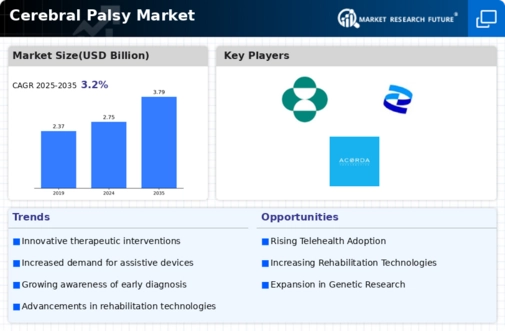Market Trends
Key Emerging Trends in the Cerebral Palsy Market
The Cerebral Palsy (CP) market has experienced significant developments reflecting a variety of approaches aimed at addressing the multifaceted needs of people suffering from this condition. Integration of state-of-the-art technologies during intervention development is one notable trend. These include robot-assisted therapy techniques such as virtual reality exercises together with wearable devices, which have been found instrumental in supplementing conventional physical therapies. There is now more emphasis on personalized care or an approach that focuses on patients' desires within the market. Since different forms of cerebral palsy manifest differently, there is a need to individualize each plan based on their special requirements as well as those capabilities they may possess. Personalizing therapeutic interventions, assistive equipment, and educational practices will thus be done to address specific challenges associated with various types/severity levels that relate to cerebral palsy. Through personalization, outcomes can be optimized, leading to improved quality of life. Innovations in assistive technology are driving changes or trends within the cerebral palsy landscape. These include custom mobility tools, communication aids, and adaptive products, which enable individuals with CP to get more involved in everyday activities than before. The changing face of cerebral palsy markets involves collaboration across disciplines, including multidisciplinary care. CP is complex and requires the involvement of various healthcare professionals like neurologists, physiotherapists, occupational therapists, and speech-language pathologists, among others. Genetic and biomarker research is influencing the cerebral palsy market by directing focus on what causes it and may contribute to its risk factors. The work in this regard has been aimed at producing targeted therapies for specific genetic or neurobiological causes of CP. Precision medicine in relation to neurodevelopmental disorders such as cerebral palsy promises a better strategy for individualized and effective treatment in this field. Notably, telemedicine and telehealth have become very popular in the Cerebral Palsy market as they can help provide ongoing support and therapies. Telemedicine platforms enable individuals with CP to access specialized care from their homes. This significantly resolves the challenges associated with geography in relation to healthcare services for them. There are regulatory initiatives and policy developments affecting cerebral palsy trends across the globe. Governments or regulatory bodies are responsible for formulating policies and guidelines, among others, that support cerebral palsy therapies, research, assistive technologies, and other accessibility issues. Greater awareness and advocacy efforts are shaping the cerebral palsy market. Also, advocacy groups play a crucial role in increasing the knowledge about cerebral palsy, reducing stigma, and advocating for supportive policies. The result is an overall inclusive society where people living with CP enjoy more acceptance.







Leave a Comment